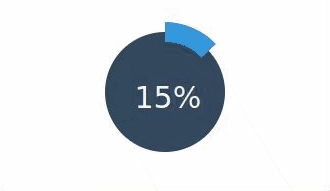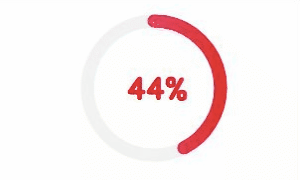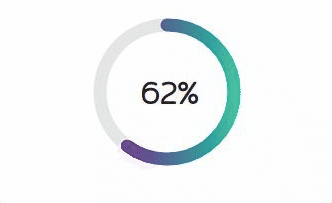@cicciosgamino/progress-ring v1.0.1
🪐 \<progress-ring>
Simple customizable progress ring 🪐!
Example One

progress-ring {
--progress-from-bottom: 10%;
--progress-from-left: 50%;
--bk-color: #34495e;
--progress-stroke-color: #3598dc;
--progress-opacity: 1;
--progress-font-family: 'Roboto', sans-serif;
--progress-font-size: 3rem;
--progress-font-color: whitesmoke;
}<progress-ring stroke="20" radius="80" progress="0"></progress-ring>Example Two

progress-ring {
--progress-from-bottom: 10%;
--progress-from-left: 50%;
--bk-color: transparent;
--footprint-stroke-color: grey;
--footprint-opacity: .1;
--progress-stroke-color: #e9008d;
--progress-stroke-gradient-color: #dc0030ff;
--progress-stroke-linecap: round;
--progress-font-family: 'Jua', sans-serif;
--progress-font-size: 3rem;
--progress-font-color: #dc0030ff;
--progress-font-weight: 600;
}<progress-ring stroke="13" radius="80" progress="10" ></progress-ring>Example Three

progress-ring {
--progress-from-bottom: 5%;
--progress-from-left: 50%;
--bk-color: transparent;
--progress-stroke-color: purple;
--progress-stroke-gradient-color: #00bc9b;
--progress-stroke-linecap: round;
--progress-opacity: .9;
--footprint-stroke-color: grey;
--footprint-opacity: .2;
--progress-font-family: 'Mitr', sans-serif;
--progress-font-size: 3rem;
--progress-font-weight: 700;
--progress-font-color: #232323;
}<progress-ring stroke="13" radius="80" progress="0"></progress-ring>Example Four

progress-ring {
--progress-from-bottom: 10%;
--progress-from-left: 50%;
--title-from-top: 10%;
--title-from-left: 50%;
--bk-color: transparent;
--progress-stroke-color: OrangeRed ;
--progress-stroke-gradient-color: salmon;
--progress-stroke-linecap: round;
--progress-opacity: .9;
--footprint-stroke-color: grey;
--footprint-opacity: .2;
--progress-font-family: 'Roboto', sans-serif;
--progress-font-size: 2rem;
--progress-font-weight: 700;
--progress-font-color: salmon;
--title-font-size: 4rem;
}<progress-ring title="🍣" stroke="10" radius="80" progress="0"></progress-ring>🚀 Usage
- Install package
npm install --save @cicciosgamino/progress-ring- Import
<!-- Import Js Module -->
<script type="module">
// Importing this module registers <progress-ring> as an element that you
// can use in this page.
//
// Note this import is a bare module specifier, so it must be converted
// to a path using a server such as @web/dev-server.
import '@cicciosgamino/progress-ring'
</script>- Place in your HTML
<progress-ring title="🍣" stroke="10" radius="80" progress="0"></progress-ring>🐝 API
📒 Properties/Attributes
| Name | Type | Default | Description |
|---|---|---|---|
| title | String | '' | Brief string to place inside the progress ring component space |
| radius | Number | 60 | Radius of the ring |
| progress | Number | 0 | Percent number passed to the component |
| stroke | Number | 10 | Stroke width, this rapresent the progress line |
Methods
None
Events
None
🧁 CSS Custom Properties
| Name | Default | Description | ||
|---|---|---|---|---|
--progress-from-bottom | 10% | Absolute positioning the progress number from bottom | ||
--progress-from-left | 50% | Absolute positioning the progress number from left | ||
--title-from-top | 40% | Absolute positioning the title from top | ||
--title-from-left | 50% | Absolute positioning the title from left | ||
--bk-color | transparent | Background color inside the circle | ||
--progress-stroke-color | #e9008d | Progress stroke color | ||
--progress-stroke-gradient-color | '' | Progress stroke stop-color if you want a gradient effect | ||
--progress-stroke-linecap | butt | SVG stroke linecap ( butt | round | square ) |
--progress-opacity | .9 | Opacity on progress stroke | ||
--footprint-stroke-color | transparent | Track under the progress stroke can be visible or transparent | ||
--footprint-opacity | 0 | Opacity on footprint stroke | ||
--progress-font-family | sans-serif | Font family for the progress counter | ||
--progress-font-size | 2rem | Font size for the progress counter | ||
--progress-font-weight | 400 | Font weight for the progress counter | ||
--progress-font-color | #000 | Font color for the progress counter | ||
--title-font-family | sans-serif | Font family for the title | ||
--title-font-size | 1.2rem | Font size for the title | ||
--title-font-color | #000 | Font color for the title |
🤖 Write HTML and JavaScript
Import the component's JavaScript module, use the component in your HTML, and control it with JavaScript, just like you would with a built-in element such as <button>:
<!doctype html>
<html>
<head>
<meta charset="utf-8">
<title>My Example App</title>
<!-- Add support for Web Components to older browsers. -->
<script src="./node_modules/@webcomponents/webcomponentsjs/webcomponents-loader.js"></script>
</head>
<body>
<!-- Use Web Components in your HTML like regular built-in elements. -->
<progress-ring id="myProgress" title="🍣" stroke="10" radius="80" progress="0"></progress-ring>
<!-- The Material Web Components use standard JavaScript modules. -->
<script type="module">
// Importing this module registers <progress-ring> as an element that you
// can use in this page.
//
// Note this import is a bare module specifier, so it must be converted
// to a path using a server such as @web/dev-server.
import '@cicciosgamino/progress-ring'
// Standard DOM APIs work with Web Components just like they do for
// built-in elements.
const p = document.querySelector('progress-ring')
let count = 0
setInterval(() => {
p.setAttribute('progress', `${(count+=1) % 100}`)
}, 100)
</script>
</body>
</html>🚀 Serve
Serve your HTML with any server or build process that supports bare module specifier resolution (see next section):
# use globally instelled
npm install -g @web/dev-server
# install the project dev-dependencies and npm run
npm install
npm run serveBare module specifiers
All @cicciosgamino Lit components JavaScript modules that use bare module specifiers. Bare module specifiers are not yet supported by browsers, so it is necessary to use a tool that transforms
them to a path (for example from @cicciosgamino/progress-ring to ./node_modules/@cicciosgamino/progress-ring/progress-ring.js).
Two great choices for tools that do this are:
- During local development, use open-wc's
@web/dev-serverwith the--node-resolveflag. - For your production deployment, build your application with Rollup using the
rollup-plugin-node-resolveplugin.
Contributing
Got something interesting you'd like to share? Learn about contributing.
Author
 |
|---|
| @cicciosgamino |
Support
Reach out to me at one of the following places:
Donate
Donate help and contibutions!
License
- Copyright © @cicciosgamino.
CSS encapsulation
The elements HTML structure is initialized in a Shadow DOM, so it is impossible to apply CSS to it. If you need to change the element's default style for any reason, you should open up a new issue (or a pull request!), describing your use case, and we'll work with you on solving the problem.
Browser support
Browsers without native custom element support require a polyfill. Legacy browsers require various other polyfills. See examples/index.html for details.
- Chrome
- Firefox
- Safari
- Microsoft Edge


